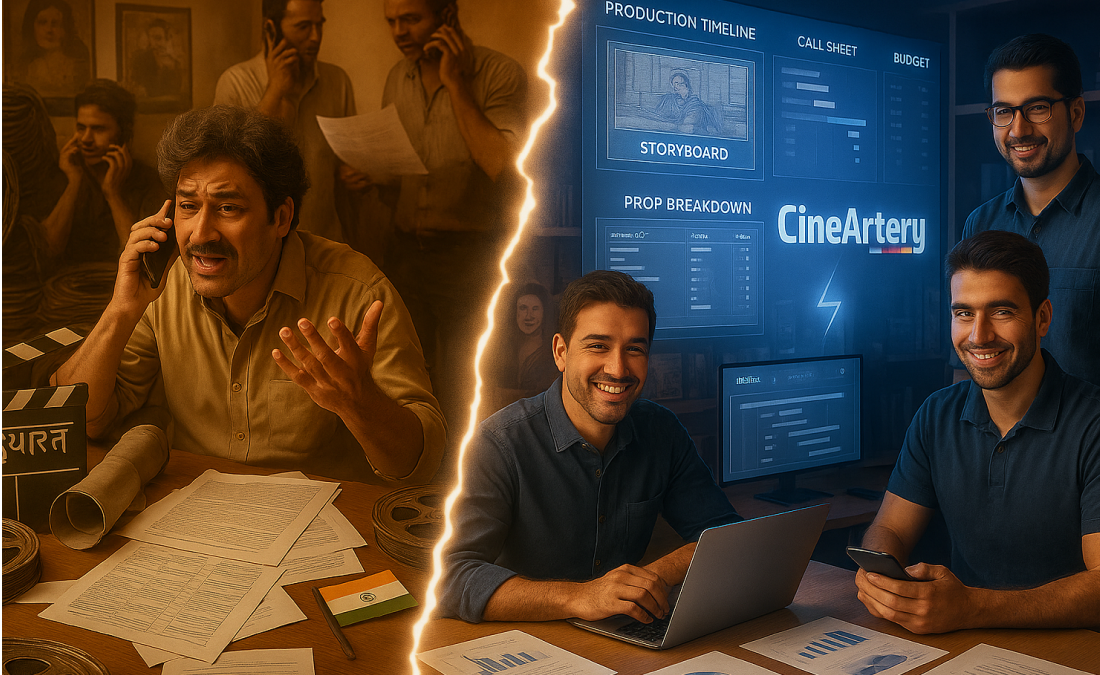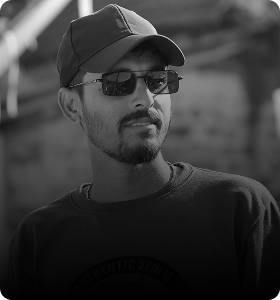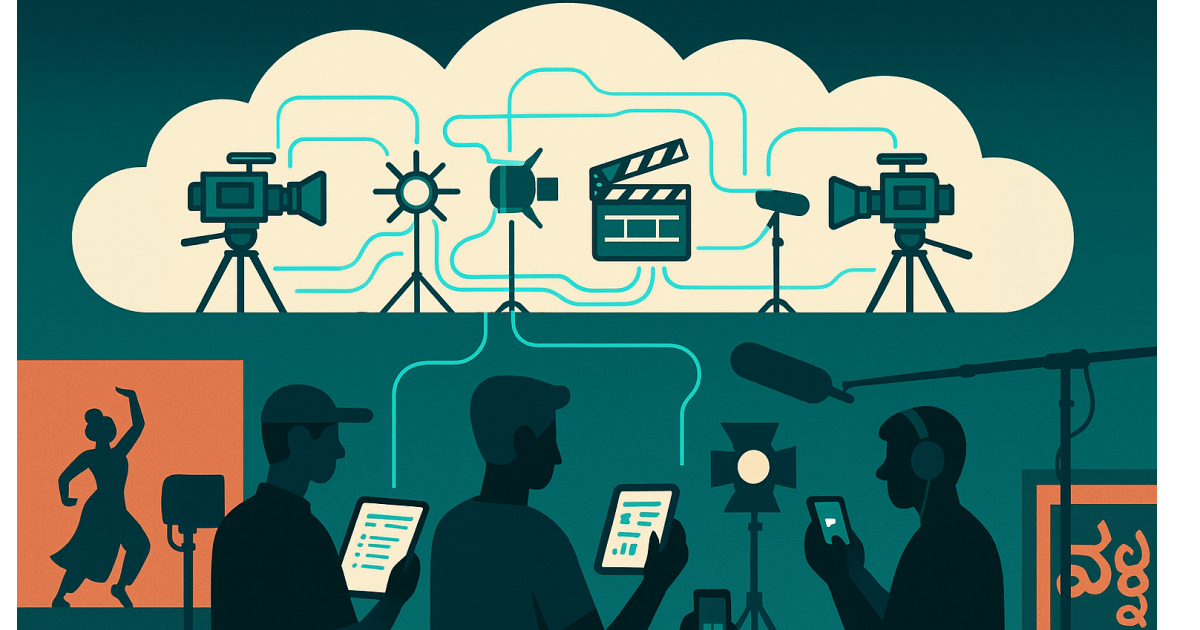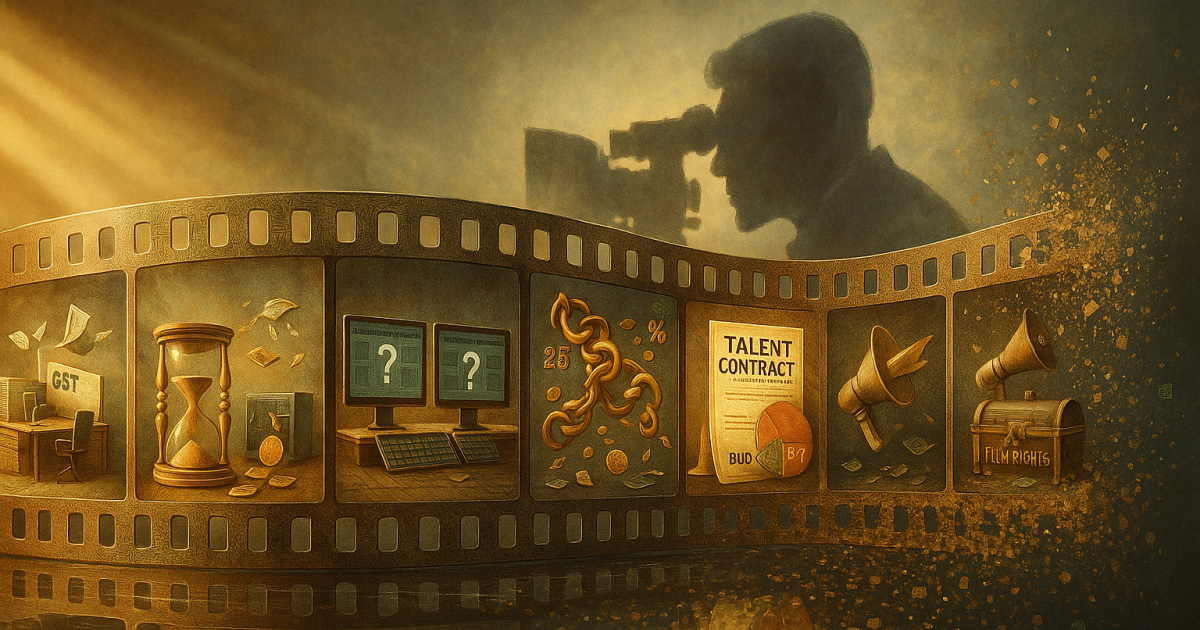Why Indian Film Productions Need a Digital Backbone

The Chaos We Pretend to Ignore, The Beautiful Mess we Call Indian Cinema
Walk onto any film set in India in the morning Call Sheet and you'll witness something remarkable. The generator guy is setting up while munching on his breakfast. The spot boys are arranging Sets work while the DOP argues with the gaffer about lighting. Three assistant directors are on their phones, each confirming different things with different people. And somewhere in this beautiful chaos, the director is sitting with a white sheet thinking of Cinematic shots in the story, mentally preparing for the day's shoot.
you’ll notice the same vibe: high energy, creative madness, and… total chaos.This is Indian cinema. Raw, passionate, and somehow, it works. It’s exciting, yes. But it’s also exhausting.
For decades, Indian film productions have run on human hustle instead of structured systems. And somehow, movies still get made. But the cost of that chaos is high—budget overruns, delays, talent mismanagement, legal disputes, marketing flops, and worst of all, lost opportunities.
But here's the thing nobody wants to admit: In 2024, Indian cinema earned ₹11,833 crore ($1.36 billion) at the box office, yet we're still running productions like it's 1994. We're the world's largest film producer by volume, making films in 22 languages, but our production methods haven't evolved much since the days of 35mm reels.
The truth is, filmmaking today is far more complex than it was even 20-10 years ago. With OTT platforms, global distribution, new tax structures, and audience expectations shifting constantly, old-school methods simply can’t keep up. What’s missing is a digital backbone—a single, integrated system that holds the entire production together.
Production Without Structure = Production Without Control
If you ask any producer about the hardest part of making a film, nine out of ten will say managing everything at once. The shoot itself is only a fraction of the journey. There’s script development, crew hiring, budgeting, legal paperwork, marketing, distribution deals, rights sales… each one with its own set of nightmares.
The film industry has transformed dramatically. The business model has changed, with increased use of digital platforms for movie releases. We're not just making films for single screens in one City anymore. We're creating content for online Platform, managing simultaneous OTT releases, handling multiple language dubs, coordinating international co-productions, and navigating GST compliance that changes every few months.
Yet most production houses still operate with:
- WhatsApp groups with 500 unread messages (and that one person who keeps sending good morning messages)
- Excel sheets that get outdated in two days, new Updates version Changes
- Personal contacts that disappear when you really need them.
- Budget tracking on the back of diary & Excel Sheet pages
- Schedule management through frantic phone calls at midnight
The irony? We use cutting-edge VFX to create entire worlds on screen, but can't figure out who has the latest version of the Script Changes, shooting schedule and others
The result? Duplicate work, missed deadlines, overspending, and in many cases, outright disasters. So we've all heard stories of films delayed for months.

The Talent Hunt Nightmare, a Problem Nobody Solves
One of the biggest pain points in filmmaking is talent management. Whether it’s actors, cinematographers, editors, or even assistant directors—finding and hiring the right people is harder than it should be.
Currently, most producers rely on personal networks or casting coordinators or last blockbuster movie teams. Newcomers/talent struggle to be seen, because they don't know the "right people." Portfolios are scattered across Instagram, random websites, or word of mouth. And there’s no reliable verification system—anyone can claim anything. Experienced professionals miss opportunities because they're not in the right networking group. And when someone drops out at the last minute? Pure panic.
Talented professionals sitting idle while productions scramble to find people. It's like having Uber drivers everywhere but still trying to find cars by walking to the main road.
Now imagine a verified talent platform—like LinkedIn, but built for film. Portfolios, past work, ratings, availability, and payment terms—all in one place. That’s not a luxury. That’s survival.
Pre-Production: Where Films Are Actually Made (or Killed) and Dreams Meet Spreadsheets/Story
Pre-production is where the film is made—or broken. Unfortunately, it’s also where chaos peaks.
Currently, pre-production looks like this:
- Budgets created on random spreadsheets templates
- Schedule planning depends on endless phone calls.
- No proper scene breakdowns until someone on set asks, "Where's the rain machine?"
- Scripts floating around in different versions (the actor has version 3, the AD has version 5, and nobody knows which one is final)
- Department heads working in silos, discovering conflicts only during shoots
Every small miscommunication here snowballs into major disasters later. If the art department doesn’t get the updated scene breakdown, they show up unprepared. If actors aren’t synced with the latest schedule, shoots get delayed. And every delay adds up in money, morale, and credibility.
Digital collaboration tools exist in other industries. But the film industry? Still stuck in the past.
Scheduling: Puzzle From Hell
Coordinating a film shoot is like solving a Rubik's cube while blindfolded, on a moving train, during an earthquake. You're coordinating lead actors dates, supporting cast, crew availability, locations permissions, equipment rentals, weather conditions, and last-minute emergencies is like juggling with fire.
Even big-budget productions often fall apart because of poor scheduling. A star’s availability shifts by a week? Suddenly the set, camera rentals, crew calendars, and marketing dates all collapse like dominoes.
What makes this worse is that everyone maintains their own calendar. The production manager has a diary, the line producer has an Excel sheet, actors' managers have their own systems, and somehow, you're supposed to make this work through Call & WhatsApp coordination.
Without a central scheduling tool where everyone can update availability in real time, teams are always playing catch-up.
Post-Production: The Graveyard of Delays
Post-production is another black hole where films bleed time and money. Editors waiting for files. VFX teams unsure of final cuts. Dubbing sessions rescheduled endlessly. Studios charging hidden costs.
Sometimes teams worked on the wrong workflow eg.
- Editor works on files, exports, uploads to Google Drive (if the internet works)
- Sound designer downloads (two days later), works, re-uploads
- Colorist can't download because the file is too large, asks for a hard drive
- Three weeks later, everyone realizes they've been working on different versions
Meanwhile, the producer is tearing their hair out because the film was supposed to release last month.
Legal & Contracts: The Ticking Time Bomb
Here’s an uncomfortable truth: more than half of Indian films don’t have proper legal agreements/contracts with cast and crew. Everything runs on trust and "verbal understanding" until something goes wrong.
The result? Payment disputes, credit fights, destroying relationships, copyright theft, and lawsuits that drag for years. Add to that the absence of e-signatures, contract storage, or centralized copyright management, and you have an industry running on blind trust. In some time a film that's been ready for 2-3years but can't be released because of a dispute over who owns what percentage.
It works—until it doesn’t.
Marketing in the Stone Age
Marketing in Indian cinema is often stuck in copy-paste mode. Poster launch (with the same six journalists). Trailer launch (with the same predictable format). City tours (with the same mall visits). Media interviews (with the same questions).
Where's the SEO strategy? Where's the targeted digital marketing? Where's the audience analytics? Where's the ROI tracking? Very few films invest in digital strategies like SEO, PR-driven branding, or campaign performance tracking.
The movie and entertainment market in India is expected to reach US$ 10,172.7 million by 2030, but we're still using yesterday's marketing playbook for tomorrow's audience.
Distribution: The Ultimate Black Box
Distribution is even more archaic. Ask any producer how much their film actually made in tier-2 and tier-3 cities, and watch them squirm. Distribution remains the industry's biggest mystery. Numbers are vague, reports are delayed, and money. often have no idea how much money their film actually made in smaller towns. The lack of transparency is staggering.
Rights & Royalties: The Forgotten Goldmine
Selling rights - OTT, satellite, audio, international and others is supposed to be a producer’s main source of profit. But most deals are handled informally, with middlemen pocketing huge cuts.
There’s no central platform for verified rights sales. No standardized contracts. No transparency in pricing. This means producers often undersell their assets, while buyers overpay without knowing the real value.
It’s a broken system begging for disruption.
Enter the Digital Backbone
None of these problems are unsolvable. They just need a structured, tech-first approach. Now imagine a different world. One platform that connects everything. Your budgets, schedules, contracts, talent database, marketing campaigns, distribution deals, all in one place. Accessible from your “Web and App”. Updated in real-time. Transparent and traceable.
Lets take examples of Restaurants that have more operational software for all the orders. Your local grocery store has better inventory management than some of the production houses.
CineArtery is building exactly this. Think of it as the operating system for filmmaking. When your production has a digital backbone:
- One central dashboard for budgeting, scheduling, and task tracking
- A verified talent marketplace for cast & crew hiring
- Real-time collaborative scriptwriting and scene breakdowns
- Schedules sync across all departments instantly
- Automated digitalized legal contracts, e-signatures, and safely stored
- Marketing tools with real-time PR/SEO integration and ROI tracking
- Distribution dashboards that link directly with exhibitors and ticketing
- A copyright sales hub where producers can list, negotiate, and sell rights transparently
This isn’t about replacing creativity. It’s about removing the chaos that kills creativity.
“Although human beings are incapable of talking about themselves with total honesty, it is much harder to avoid the truth while pretending to be other people.
By Akira Kurosawa
CineArtery: Building That Backbone
That’s exactly what CineArtery is setting out to do. A single cloud-based platform that simplifies film production by connecting every stage of the process into one ecosystem. Think of it as the operating system for films. Just like businesses moved from paper ledgers to digital ERPs, filmmaking now needs its ERP moment. CineArtery is building that moment—with smart dashboards, mobile apps, and tools designed specifically for cinema.
- Producers get clarity and control.
- Talent gets visibility and verified credibility.
- Crew members get smoother workflows and fewer delays.
- Distributors and exhibitors get transparent revenue tracking.
- And audiences? They get better films, faster.
But most importantly, if you're someone who loves cinema, this means better films. Because when filmmakers spend less energy on managing chaos, they have more energy for creating magic.
Wrapping Up: Chaos Isn’t Creative
Filmmaking will always be messy—that’s part of the charm. But chaos shouldn’t be the default system. When your budget leaks money, when your schedule falls apart, when your rights are undersold, when your crew burns out—that’s not creativity. That’s negligence.
A digital backbone isn’t about killing the magic of cinema. It’s about protecting it. By bringing order to the madness, filmmakers can spend less time chasing spreadsheets and more time telling stories that matter.
Comments

Variations in the floor plan, window location, and interstitial outdoor spaces enhance this material homogeneity. The goal was to produce a unified whole using a modern design language, where attention to materiality and detail is evident.

Variations in the floor plan, window location, and interstitial outdoor spaces enhance this material homogeneity. The goal was to produce a unified whole using a modern design language, where attention to materiality and detail is evident.

Variations in the floor plan, window location, and interstitial outdoor spaces enhance this material homogeneity. The goal was to produce a unified whole using a modern design language, where attention to materiality and detail is evident.
-
42
-
10
-
Publication Date
October 15,2023
-
Author name
Bharatvarsh
-
Reading Time
20 Min
-
Number of Words
1800
Table of Contents
- Introducation
- The Chaos We Pretend to Ignore, The Beautiful Mess we Call Indian Cinema
- Production Without Structure = Production Without Control
- Pre-Production: Where Films Are Actually Made (or Killed) and Dreams Meet Spreadsheets/Story
- Scheduling: Puzzle From Hell
- Post-Production: The Graveyard of Delays
- Legal & Contracts: The Ticking Time Bomb
- Marketing in the Stone Age
- Distribution: The Ultimate Black Box
- Rights & Royalties: The Forgotten Goldmine
- Enter the Digital Backbone
- CineArtery: Building That Backbone
- Wrapping Up: Chaos Isn’t Creative






Leave a comment